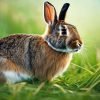Unlocking the fascinating natural world we inhabit entails delving into the intriguing narratives of evolution, adaptation, and survival that define the millions of species around us. This discourse aims to uncover the natural history of two remarkable creatures – the Kangaroos and Rabbits. From the arid outbacks of Australia to the leafy warrens of Europe, these animals have honed distinctive survival strategies, etching unique stories into the vast weave of life. Our journey will traverse the evolutionary timelines of these species, inspect the marvels of their anatomy and physiology, and decode their behavioral patterns within their respective ecosystems. Within the vast tableau of nature’s grand opera, let us discover how these two seemingly different actors play their parts.
Evolutionary Biology of Kangaroos and Rabbits
Evolutionary Pathways: A Comparative Study on Kangaroos and Rabbits
The world of fauna is intriguing, especially when one starts diving into the evolutionary paths of different species. One particularly fascinating comparison can be made between the transcendental developmental trajectories of two disparate yet allied species – the kangaroos of the Australian outback and the rabbits common in varied landscapes worldwide.
Firstly, their shared characteristic of being herbivores paves common grounds; however, a deeper examination engenders astonishing parallels in their evolutionary histories, including, crucially, their mode of reproduction. Both species belong to the cohort of mammals referred to as marsupials – defined by an unusual reproductive methodology, which signifies embryonic transfers from the internal uterus to an external pouch for prolonged nurturing. This distinctive adaptation appears to reinforce their survival capabilities in harsh environmental conditions.
Simultaneously, the anatomical distinctions are striking. Kangaroos, belonging to the family Macropodidae, developed powerful hind legs explicitly adapted for leaping in an open environment, while maintaining petite, almost feeble forelimbs. In contradiction, Rabbits, classed under family Leporidae, exhibit a more balanced corporeal structure with equal strength distribution throughout their legs, though they are also well-established jumpers.
Genetic studies have signified similar retrotransposon integrations in the genomes of both organisms, embodying another layer of interconnectedness in their developmental paths. Retrotransposons, colloquially labeled as “jumping genes”, are segments of DNA that can essentially replicate themselves to different sites within the genome. These insertions tend to be unique to each species, hence shared integrations indicate a potential past connection – a communal snapshot in their collective evolution.
Behavioural nuances are also of paramount importance in understanding their evolutionary bifurcation. The cathemeral behaviour (active during day or night) of kangaroos, characterized scientifically as diurno-nocturnality, is distinctly contrasting with the crepuscular lifestyle adopted by rabbits – largely active during twilight, dawn and dusk. This disparity further hints at a divergence, adapting to acute niches in the ecological landscape.
Linkages in their phylogenetic trees have turned into hotspots for controversy amongst taxonomists. Despite robust morphological differences, their shared marsupial characteristic entwines their fates into overlapping strands of the evolutionary web. However, the consensus is that these overlapping strands are deceptive. Rather than evolving from a common ancestor, this shared characteristic is now widely believed to be a product of convergent evolution, where similar traits develop independently in different species adapting to similar environmental pressures.
The comparison between kangaroos and rabbits offers enlightening yet paradoxical insights into the magic box of evolution. Even as molecular evidence and behavioral assessments piece together a jigsaw puzzle, there is much yet to be discovered in interpreting the enigmatic maze of evolutionary pathways. Taking these factors into account, the intricate blend of similarities and differences underlines the resounding power of natural selection in shaping the amazing biodiversity we witness today.

Comparative Anatomy and Physiology
The comparative anatomy and physiology of kangaroos and rabbits reveal myriad remarkable similarities and differences. Often, an amalgamated understanding of these two species can shed light on the complex orchestration of these traits.
Beginning with musculoskeletal structures, kangaroos and rabbits both use powerful hind limbs for locomotion. However, the modality of use significantly differs — kangaroos primarily engage in saltatory locomotion, leveraging their long, robust hind limbs and substantial tail for balance during bipedal hopping. In contrast, rabbits typically resort to quadrupedal locomotion but can assume a bipedal hop for quicker pace, relying less on their considerably smaller tail for balance.
Shifting focus to the digestive system, both kangaroos and rabbits represent the class of herbivores, but their respective gastrointestinal physiologies vary distinctly. Kangaroos employ foregut fermentation, with an elaborate forestomach adapted for microbial cellulose digestion. On the other hand, rabbits are hindgut fermenters, channeling undigestible material to the cecum for fermentation. Uniquely, rabbits also practice cecotrophy – the consumption of special fecal pellets generated in the cecum, allowing a second pass through the digestive system to extract maximum nutritional value.
Regarding the respiratory system, both kangaroos and rabbits exhibit the common mammalian trait of bilateral lungs with lobulations. Notably, kangaroos possess expansively large, elongated lungs, advantageous for effective gas exchange during their physically demanding locomotion style. Rabbits, however, have smaller, compact lungs, apt for their size and lifestyle.
Circulatory adaptations are also remarkable. Kangaroos, compared to rabbits, have a heart structured to handle colossal blood flow during high-speed hopping. Furthermore, they can alter their heart rate to conserve energy when not in motion. In rabbits, their hearts – proportionally larger than that of a kangaroo relative to body size – pump blood at a quick rate, handy in emergencies for a speedy escape from predators.
Turning to their sensory systems, kangaroos have acute hearing and robust olfaction, compensating for their limited color perception. Rabbits boast impressively expansive peripheral vision, being a small prey species and are endowed with keen auditory and olfactory senses similar to kangaroos.
The reproductive system delineates distinctively between kangaroos and rabbits. As marsupials, kangaroos exhibit less developed, bifurcated reproductive anatomy compared to placental mammals; however, they possess an extraordinary adaptation to embryonic diapause – the ability to suspend an embryo’s development in times of environmental stress. Conversely, rabbits, as prolific breeders, have a shorter gestational period and larger litter sizes, but lack the kangaroo’s defining ability of embryonic diapause.
As such, the anatomical and physiological comparative study between kangaroos and rabbits opens numerous gateways to understanding their adaptable structures, evolutionary strategies, environmental interactions, and survival mechanisms. It is through these meticulous investigations that the true breadth of biodiversity comes to light, grounding our appreciation and respect for the prodigious power of nature.

Behavior and Ecology
Commencing with musculoskeletal structures, kangaroos, and rabbits exhibit marked differentiations in their adapted locomotion techniques. Kangaroos are elusively renowned for their unique mode of locomotion: bipedal saltation, rapidly covering considerable distances with a conjunction of force generated from the hind legs and balance maintained by a robust tail. Conversely, rabbits employ quadrupedal hopping, notably less efficient but perfectly suited to swift, unpredictable movement in an evasion of predators.
Anatomically, the kangaroo’s hind limbs have evolved longer than their forelimbs, ceding a crucial advantage in high-speed hopping. Rabbits, on the other hand, possess relatively homogenous limb lengths, a correlate of their quadrupedal stance.
Turning now to digestive systems, the stark contrast between the herbivorous nutrition of kangaroos and omnivorous tendencies in rabbits unrolls. Kangaroos, as ruminants, harbor a special form of microbial rumen fermentation, which enables them to effectively breakdown the tough cellulose in their diet of predominant shrubs and grasses. On the contrary, rabbits adapt to an omnivorous diet inclined to swift ingestion while the slow process of digestion buttressed by caecotrophy occurs later in safety.
Respiratory adaptations maintain a crucial role in their survival, especially for kangaroos residing in the often arid Australian outback. Interestingly, during hops, a kangaroo’s gut content’s forward and backward motion aids in inducing exhaling and inhaling. Furthermore, the highly vascularized nasal passage in kangaroos promotes water conservation, a physiological adaptation of paramount significance given their typical habitats.
Disparity presents itself again in circulatory adaptations. Whilst the rabbit, a smaller creature, has a quicker heart rate, the kangaroo’s heart has received evolutionary finesse to improve efficiency during hopping – a strong counter-current exchange system for oxygen supply that ensures metabolic wastes’ rapid clearing.
A comparison of their sensory systems reveals further distinctions. Regarded as crepuscular, rabbits possess highly adapted vision which allows them to detect predators under low light. Contrastingly, kangaroos possess excellent hearing and sight, complemented by a good sense of smell. It is speculated that the 360-degree vision that kangaroos possess plays an instrumental role in detecting threats.
Reproductive strategies display inherent differences stemming from their separate classifications as marsupials and placental mammals. Kangaroo newborns, termed joeys, are transferred post-birth into the maternal pouch for continued development, whereas rabbits undergo a more extended gestation phase, producing altricial young that require sustained parental care postparturition.
Anatomical and physiological adaptations galore, including the kangaroo’s specialized water conservation measures, such as producing concentrated urine, and the rabbit’s large ears that facilitate efficient thermoregulation, highlight evolution’s artistry in the face of survival imperatives imposed by their respective, often severe, environments.
These remarkable distinctions and strategies underscore an essential thread tying these species together: the intricate intertwining of evolutionary paths and environmental interfaces. This tale of evolution underlines the dynamic interplay fueling the diverse idiosyncrasies that characterize these remarkable species – kangaroos and rabbits. Their fascinating ecology serves as a potent reminder of the marvellous complexity and the inherent connectivity of life on our planet.

Through the discourse, we have journeyed along the twisting trails of evolution that birthed the Kangaroos and Rabbits, explored the intricate weave that comprises their anatomy and physiology, and unraveled the intricacies of their behavior within their home stages. Ours was a voyage celebrating life’s diversities and marveling in nature’s ingenuity, resulting in a deeper understanding and appreciation of the world around us. As we conclude, remember the interconnectedness of all creatures; how the unique characteristics of the Kangaroo and the Rabbit – their adaptability, physiology, and behavior – all play integral roles in the magnificent and ceaseless symphony that is the ecology of our planet.



